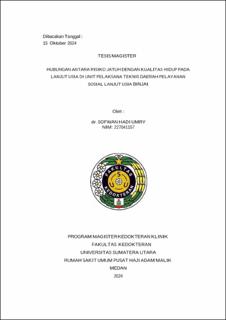Hubungan antara Risiko Jatuh dengan Kualitas Hidup pada Lanjut Usia di Unit Pelaksana Teknis Daerah Pelayanan Sosial Lanjut Usia Binjai
The Relationship Between Fall Risk and Quality of Life in Elderly in Regional Technical Implementation Unit of Social Service for Elderly Binjai

Date
2024Author
Umry, Sofwan Hadi
Advisor(s)
Iqbal, Kiki Mohammad
Fitri, Fasihah Irfani
Metadata
Show full item recordAbstract
Introduction: Elderly people or often known as seniors are people who have experienced aging.
marked with the decline a number of function body. The amount decline function body Which
experienced a elderly people cause a decrease in the quality of life in the elderly, one of which is that
the elderly often experience disorders balance, thus increasing the risk of falls. The number of elderly
people will increase from year to year. the year from total resident Indonesia. Study This aiming For
evaluate connection between risk fall using the Berg Balance Scale (BBS) instrument with quality life
on elderly.
Method: This research is analytical in nature with a cross-sectional data collection method without...
treatment with primary data sources of 36 elderly people obtained from all elderly patients at the
technical implementation unit of the Binjai elderly social service area. fulfil inclusion criteria And
exclusion, sign letter agreement follow study. Fall risk assessment using the Berg Balance Scale
(BBS) instrument, while quality life rated use questionnaire SF-36.
Results: The majority of the study subjects were women, 21 people (58.3%), with an average age of
62.8 years, and 9 people (25%) fell. In the balance examination using the BBS, 75% of respondents
had a low risk of falling. Quality of life measured using the SF-36 showed that 97.2% of respondents
had a good quality of life with an average score of 72.5. Overall, the majority of respondents had a
low risk of falling and a high quality of life. The results of statistical analysis showed a significant
relationship between the Berg Balance Scale (BBS) and the quality of life of the elderly as assessed
using the SF-36 questionnaire (p = 0.001).
Conclusion: There is a relationship between the Berg Balance Scale (BBS) and the quality of life of
the elderly.
Keywords: Berg Balance Scale), SF 36, quality of life, Risk Fall, elderly.
